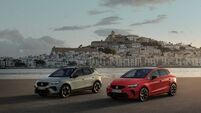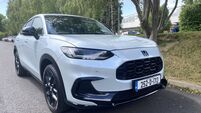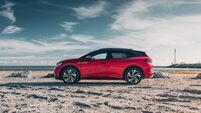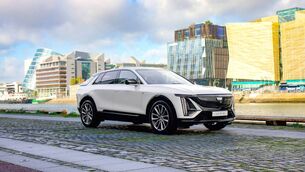Cupra’s Tavascan designed to push boundaries
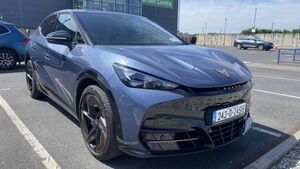
The car’s distinctive sculpted exterior design, a blend of SUV and coupe body style, and contrasting copper accents give it a sense of purpose and speed.
The Cupra Tavascan, an all-electric SUV coupe built on the Volkswagen Group’s MEB platform, boasts a powerful personality centred on design and performance. Launched this year, it’s the brand’s first electric SUV coupe and shares the platform with VW ID. models, Audi’s Q4 e-tron, the Skoda Enyaq iV, and Cupra Born.
With a claimed range of 503-568 km on a full charge, a 77kWh battery, and a maximum torque of 545 Nm, the Tavascan offers impressive efficiency. Its boot capacity is 540 litres, and the road tax is €120. The Endurance model starts at €44,365, while the VZ model starts at €70,210.
The car’s distinctive sculpted exterior design, a blend of SUV and coupe body style, and contrasting copper accents give it a sense of purpose and speed. The front features striking matrix LED headlights with a three-triangle signature, and the illuminated copper-coloured Cupra logo is prominently displayed on the bonnet. The rear is equipped with elegant edge-to-edge lighting that emphasises the car’s width, particularly at night. The Cupra logo is also displayed here.
Due to its height, the vehicle is easy to enter and exit. The driver sits high with excellent visibility from the forward-reaching windscreen and side windows, although the A-pillar windows are relatively small. Rear visibility is limited by the small rear window due to the slope of the roofline and the thick rear pillars. There is no rear wiper.
A wide copper bar runs across the curved dashboard, which houses a large 15-inch touchscreen with the brand’s new graphics. The touchscreen is user-friendly and includes navigation, wireless Apple CarPlay and Android Auto, among other features. Below the screen are permanent climate control controls, while in-between these are white bars for volume controls, all of which are easy to use while driving.
The digital stand-alone 5.3-inch digital cluster in front of the driver provides essential driving information.
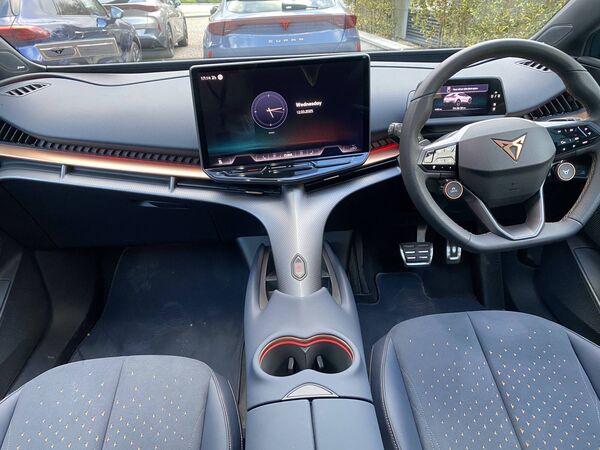
The central area, described as a ‘central spine’ sweeping downwards in a Y shape between the dashboard and console, may not be to everyone’s taste. The design and the hard grey trim used, which resembles snake skin, are not to everyone’s liking. In fact, I have accidentally hit the warning triangle near the base of the spine on several occasions. There is a good storage area below with two small C-type USB ports and a wireless mobile phone charger.
The panoramic glass sunroof with treated glass lets in plenty of daylight without reducing rear headroom. The colourful ambient lighting around the dashboard and cabin can be distracting at night, but the sunroof and backlit perforated door panels are visually striking. These features add to the car’s cost.
The bucket-type seats are elegantly patterned and upholstered with at least 50% recycled microfibre. They have integrated headrests and are comfortable, especially during cornering. The front seats have power adjustments, lumbar support, three memory settings, and heating.
The multi-function steering wheel has two satellite buttons for drive modes Comfort, Normal, and Sport, and a ‘Cupra’ mode that improves performance. The transmission selector and electronic parking brake are located off the steering wheel. Energy recuperation is available at several levels, selected by the paddles behind the steering wheel. A head-up display projects current speed onto the windscreen.
The driver’s door has only two window opener switches, which is inconvenient since all four should be on the driver’s door.
Rear passengers have ample space and legroom due to the flat floor, which is comfortable for the central occupant. However, the rear bench only seats two adults for long journeys. The armrest has cupholders and access to the boot. There are two USB ports in the rear.
The car has a power tailgate and a substantial 540 litres of boot space with a two-level floor and a compartment for charging cables. There’s no front ‘frunk’.
The vehicle features a comprehensive reversing camera with an overhead view, front and rear parking sensors, and Park Assist for semi-autonomous parking in tight spaces. Visual and sound warnings alert the driver if other vehicles approach when reversing. If the driver doesn’t brake, the system autonomously brakes to avoid accidents.
Two trim levels are available: rear-wheel-drive (RWD) Endurance (levels 4, 6, and 7) with 286hp and a claimed range of 553km, and four-wheel-drive (4WD) VZ with 340hp and all-wheel-drive, with a slightly reduced range of 521km. Both models use the same 77kWh powerful lithium-ion battery and share a substantial torque of 545Nm, resulting in an efficiency of approximately 15.2 to 17.3kWh/100km.
The vehicle accelerates impressively, with the Endurance model reaching 100km/h in 6.8 seconds and the VZ model in 5.5 seconds.
The Tavascan can be charged from 10-80% using DC fast charging in 28 minutes, while AC charging takes eight hours.
The Tavascan boasts 19-inch Aero wheels, Matrix LED lighting, rear 3D lights, parking sensors, Connected Travel Assist, rear privacy glass, aluminium pedals, a 3-zone climate control system, and a tool kit. The VZ model upgrades to 20-inch alloys, Dynamic Chassis Control, and Side Assist/Exit Assist. Travel Assist includes adaptive cruise control, lane-keeping assistance, and traffic jam assist, contributing to its five-star safety rating from Euro NCAP.
Exotic exterior colours include Atacama Desert, White Silver Metallic (€860), Taviscan Blue Special Metallic, and Basalt Grey Special Metallic (€1,089).
The Tavascan is well-proportioned, with instant acceleration, a balanced steering feel, and smooth motorway cruising. While the suspension occasionally felt heavy on uneven roads, it never caused discomfort.
Named after a village in the Pyrenees, the Tavascan is designed and developed in Barcelona but manufactured in the Volkswagen Group’s Anhui plant in China, which specialises in electric vehicle production.
PRICES: Endurance from €44,365; VZ from €70,210.
